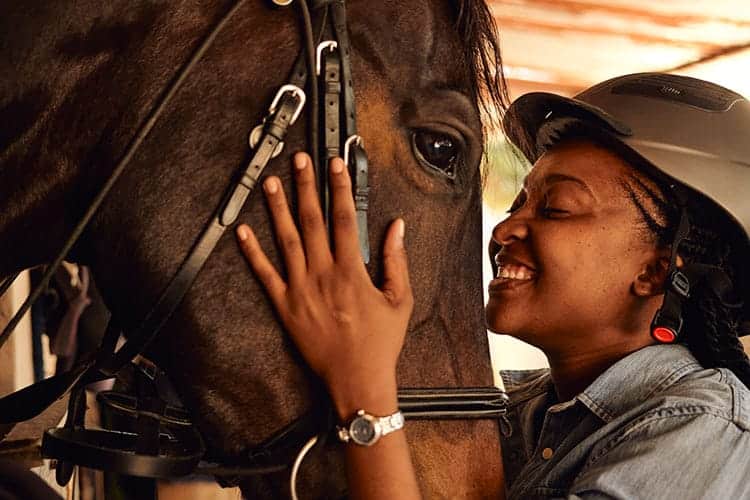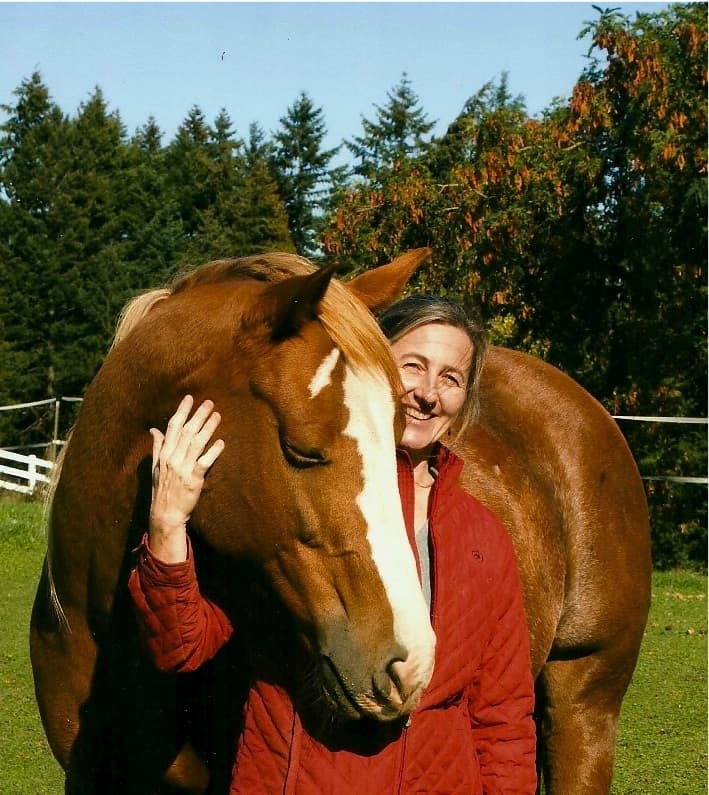Do You ‘Baby Talk’ to Your Horse? She Hears You
- Posted by Robin Foster, PhD, Cert. Applied Animal Behaviorist (CAAB), Cert. Horse Behavior Consultant (CHBC)

Do you talk to your horse? If so, your speaking style matters, according to new research by Lea Lansade, PhD, and colleagues from Université de Tours in France. The article, “Horses are sensitive to baby talk: pet‐directed speech facilitates communication with humans in a pointing task and during grooming,” was published in the March 2021 issue of Animal Cognition.
This is the first study to provide evidence that human speech style can affect equine behavior. Lansade was particularly interested in the use of pet-directed speech (PDS) with horses. PDS has the same sound qualities as baby talk (also called infant-directed speech , Motherese, and Parentese). This style of speaking has a distinctive vocal signature, with a high pitch and slow rate.
PDS captures a horse’s attention and improves human-horse communication
The research began with a social media survey. Most horse owners who responded to the survey claimed to talk to their horse using PDS, but fewer than half thought the horse was actually sensitive to it. The researchers then conducted two experiments with 20 Welsh mares comparing the effects of PDS and adult-directed speech (ADS). They found that:
- PDS was more effective at capturing the horses’ attention than ADS.
- Horses were more likely to follow a pointing gesture when the person spoke using PDS.
A similar attention-grabbing effect of ‘baby talk’ is seen in infants and dogs.
In the first experiment the researchers set up naturalistic grooming sessions to compare the effects of PDS and ADS. In one two-minute grooming session a young female research assistant spoke to the horse using PDS, and in another grooming session the same person spoke using ADS. The study found that horses were calmer and more likely to look at and reciprocally groom the person when she used PDS. Interestingly, none of the horses reciprocally groomed the person when she used ADS.
In the second experiment they set up a pointing task using two buckets containing food. The team found that when the person spoke using PDS while dynamically pointing toward one bucket, the horse was more likely to go to that bucket, but when the person spoke using ADS the horse went to either bucket.
PDS and emotional qualities of speech
In adult conversations words have meaning that create a rich story. Horses can understand some words, but as is true with dogs and infants, their vocabulary is limited. It makes sense that in real-life situations horses would tend to habituate and learn to ignore ADS.
Language is also loaded with emotional valence and tonal qualities. Lansade and colleagues suggested that PDS might capture a horse’s attention because it conveys information about the person’s positive emotional state and good intentions. Importantly, facial expression was explicitly linked to speech style in this study; the person wore a smiling face when using PDS and a neutral face when using ADS. The authors acknowledged that horses recognize and respond to relaxed, happy facial expressions in humans, which raises the question: Were the horses responding to the person’s speech style or facial expression?
More questions about PDS
This research takes an important first step toward understanding how human speaking style impacts communication with the horse, but it also raised some questions for me.
- In addition to PDS, what other styles do people use when talking to their horses and how common are they?
- How well do the findings of this study hold up for male speakers, for stallions and geldings, and in other situations?
- People use all kinds of tactics to grab a horse’s attention—making loud noises, waving a crop, holding out a carrot—but is baby-talk more effective?
- The Princeton Neuroscience Institute reported mutual gazing, joint attention to objects, and—most intriguing—synchronized brain activity between mothers who spoke baby talk and their infants. Could PDS similarly enhance the human-horse connection?
Closing comments and suggested readings
The Lansade study reviewed in this commentary has exploded on social media, which might reflect a growing interest in human-horse relationships and equine welfare. Lansade and colleagues at Université de Tours have published the following papers in the past year on emotions, communication, and human-horse interactions that might be of interest to the reader:
- Horses feel emotions when they watch positive and negative horse-human interactions in a video and transpose what they saw to real life. Animal Cognition (2020)
- Unwilling or willing but unable: can horses interpret human actions as goal directed? Animal Cognition (2020)

Written by:
Robin Foster, PhD, Cert. Applied Animal Behaviorist (CAAB), Cert. Horse Behavior Consultant (CHBC)
Related Articles
Stay on top of the most recent Horse Health news with













2 Responses
Not only does baby talk work with my horses, it also works with my quail and rabbits. I can call them to come eat and they come running.
Maureen
I completely agree with this, I found the horses that I work with almost always respond to “baby talk”, just nicely talking to them seems to put them ease. And I have seen what happens when others have spoken loudly or harshly (not me) to them when the handler isn’t getting the response that they want.
I think in general if speak to anything in calm voice it will go a lot smoother.
Great article.
Chris S.